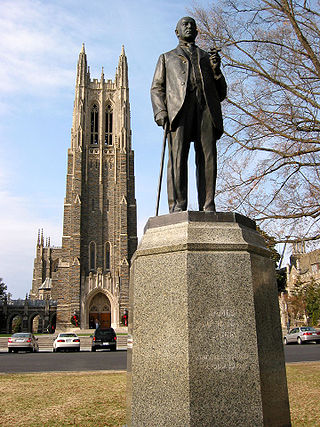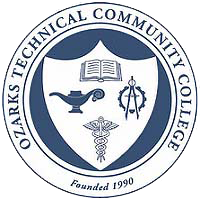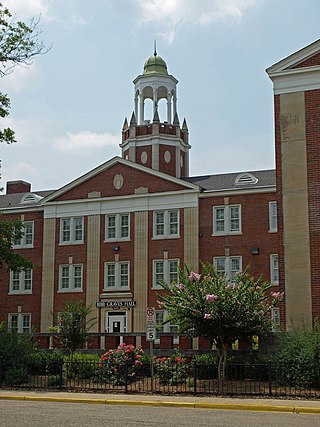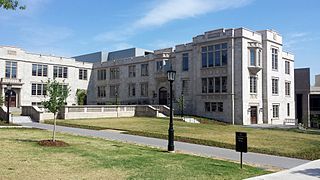
Phelps County is a county in the central portion of the U.S. state of Missouri. As of the 2020 United States Census, the population was 44,638. The largest city and county seat is Rolla. The county was organized on November 13, 1857, and was named for U.S. Representative and Governor of Missouri John Smith Phelps.

Greene County is located in the southwest part of the U.S. state of Missouri. As of the 2020 census, its population was 298,915. making it the fourth most-populous county in Missouri.

Christian County is located in the southwestern part of the U.S. state of Missouri. As of the 2020 census, its population was 88,842. Its county seat is Ozark. The county was organized in 1859 and is named after Christian County, Kentucky, which in turn is named for William Christian, a Kentucky soldier of the American Revolutionary War.

Ozark is a city in and the county seat of Christian County, Missouri. Its population was 21,284 as of the 2020 census. Ozark is also the third largest city in the Springfield, Missouri Metropolitan Area, and is centered along a business loop of U.S. Route 65, where it intersects with Missouri Route 14.

Charles Keck was an American sculptor from New York City, New York.

College of the Ozarks is a private Christian college in Point Lookout, Missouri. The college has an enrollment of 1,426 and over 30 academic majors in Bachelor of Arts and Bachelor of Science programs.

Arkansas Tech University (ATU) is a public university in Russellville, Arkansas, United States. The university offers programs at both baccalaureate and graduate levels in a range of fields. The Arkansas Tech University–Ozark Campus, a two-year satellite campus in the town of Ozark, primarily focuses on associate and certificate education.

Ozarks Technical Community College (OTC) is a public community college in Springfield, Missouri. It was established by Springfield and thirteen surrounding public school districts on April 3, 1990. It has six locations in southern Missouri. Students can earn a one-year certificate, two-year Associate of Applied Science degree (A.A.S.), Associate of Science (A.S) or Associate of Arts degree (A.A.). It is accredited by the Higher Learning Commission and had a fall 2021 enrollment of 10,506 students.

David R. Francis Quadrangle is the historical center of the University of Missouri in Columbia, Missouri. Known as The Quad, it is the oldest part of Red Campus and adjacent to Downtown Columbia at the south end of the Avenue of the Columns. At its center are six Ionic columns, all that remains of the original university building Academic Hall. Twelve buildings front the modern quadrangle including the domed main administration building Jesse Hall, the tallest building in Columbia. The Quad was designed and constructed by architect Morris Frederick Bell and his assistant William Lincoln Garver. It is named after Missouri governor David R. Francis. Eighteen structures, including the entire quad and most of Red Campus are listed as the Francis Quadrangle National Historic District. An obelisk, the original tombstone of Thomas Jefferson, stands in front of the Chancellor's Residence. It was gifted to the University by Jefferson's descendants in recognition of Missouri's ties to Virginia. In front of Jesse Hall stand markers honoring university president Richard Henry Jesse and Missouri governor David R. Francis. Nearby is another obelisk in memory of Missouri's first U.S. senator David Barton, The Missouri School of Journalism is located at the northeast corner of The Quad, comprising Walter Williams Hall, Neff Hall, Gannet Hall, along with the Reynolds Journalism Institute. To the west, Switzler Hall is the oldest academic building on campus, though the Residence on the Quad, home of the chancellor, is the oldest building overall. The University of Missouri College of Engineering completes the west side. Pickard Hall is currently closed due to radiation contamination from turn of the century experiments. Swallow Hall was recently renovated and houses the Departments of Anthropology, Visual Studies and Ancient Mediterranean Studies.

Bromley College of Further and Higher Education, trading as London South East Colleges (LSEC), is a large college of further education and higher education operating in south-east London, England. It is a partner college of six of the twelve schools of the University of Greenwich. LSEC was established in 2016 by the amalgamation of Bromley College, Greenwich Community College and Bexley College. Its largest campus is in the town of Bromley, and others are situated in Erith, Plumstead and Orpington.

Arsenal Technical High School, commonly referred to as Tech or Arsenal Tech, is a public high school in Indianapolis, Indiana, United States, which is run by the Indianapolis Public Schools district. The school is located on a 76-acre (31 ha), multiple building campus east of downtown Indianapolis, and is the only such type school in Indiana.
The University of Arkansas Campus Historic District is a historic district that was listed on the National Register of Historic Places on September 23, 2009. The district covers the historic core of the University of Arkansas campus, including 25 buildings.

William Butts Ittner was an American architect in St. Louis, Missouri. He designed over 430 school buildings in Missouri and other areas, was president of the St. Louis Chapter of the American Institute of Architects from 1893 to 1895, was awarded an honorary degree by the University of Missouri in 1930, served as president of the Architectural League of America during 1903–04, and at the time of his death was president of the St. Louis Plaza Commission, a fellow and life member of the American Institute of Architects, and a thirty-third degree Mason. He was described as the most influential man in school architecture in the United States and has a star on the St. Louis Walk of Fame. He was appointed St. Louis School Board commissioner in 1897 and is said to have designed open buildings that featured "natural lighting, inviting exteriors, and classrooms tailored to specific needs." In 1936, Ittner died. His legacy is survived by the William B. Ittner, Inc. and Ittner & Bowersox, Inc. architecture firms in St. Louis.

The Alabama State University Historic District is a 26-acre (11 ha) historic district at the heart of the Alabama State University campus in Montgomery, Alabama. It contains eighteen contributing buildings, many of them in the Colonial Revival style, and one site. The district was placed on the Alabama Register of Landmarks and Heritage on August 25, 1994, and the National Register of Historic Places on October 8, 1998.

Gearhart Hall at the University of Arkansas is a building on the university's campus in Fayetteville, Arkansas. The building was added to the National Register of Historic Places in 1992.

The Edward W. Bok Technical High School was a public high school in Philadelphia, Pennsylvania, designed by Irwin T. Catharine and named after literary figure Edward William Bok, editor of the Ladies' Home Journal. It was completed in February 1938 by the Public Works Administration (WPA) as a vocational high school at 8th & Mifflin Streets. As part of the Philadelphia Public Schools' Multiple Property Submission, the school was listed on the National Register of Historic Places in December, 1986. Bok High School was reorganized in 2006-2007 to prepare students for jobs in modern technology. After the 2012-2013 school year, the school was closed. In 2014, the school was renovated to become a home for over 200 businesses including restaurants, apartments, daycares, and hair salons.

Murrell Dobbins Career & Technical Education High School, also known as Murrell Dobbins Vocational High School, is a historic vocational school building located in the West Lehigh neighborhood of North Philadelphia, Pennsylvania, United States. It is part of the School District of Philadelphia. The building was designed by Irwin T. Catharine and built between 1936–1937. It is a six- to seven-story, 14-bay, brick building in the Moderne-style. It has a one-story, stone front building. It features brick piers with terracotta tops and the building has terra cotta trim.

O'Reilly General Hospital was an army hospital created by the U.S. Government in February 1941. It was built in Springfield, Missouri to provide long-term medical care for returning soldiers of World War II. It became known as "The hospital with a soul."

The Park Street School is a historic school building at 60 Park Street in Springfield, Vermont.Built in 1895 and enlarged in 1929, it was the town's first high school to be built after the consolidation of district schools began. It served as a high school until 1968. The building was listed on the National Register of Historic Places in 2020. The building now houses a worker training organization and residences.

Simmons Colored School is a historic building and a former African American school in The Ville neighborhood of St. Louis, Missouri, U.S.. It served as a historically segregated African American elementary school and middle school from 1898 until 1930. The building served as the Stowe Teachers College campus, an African American normal school and junior college from 1930 until 1940. The building has played an important role in The Ville community since its inception. The school was also known as Elleardsville School for Colored Children No. 8, Colored School #8, Simmons Middle School, and Simmons School.























